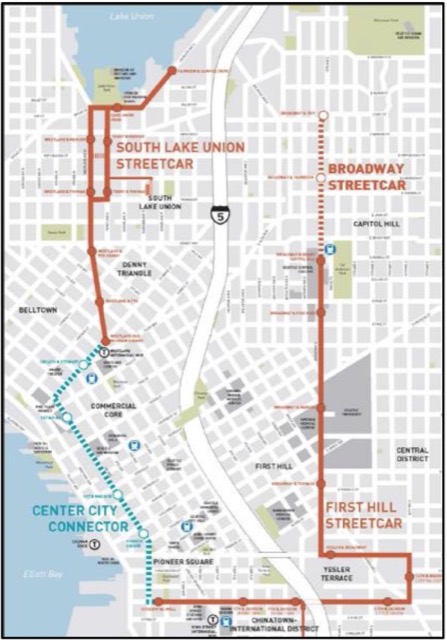Streetcars are supposed to be the least-expensive form of rail transit, yet Seattle is spending $177 million building a 1.2-mile streetcar line. At $147.5 million a mile, that’s more expensive than many light-rail lines.
The 1.2-mile City Center Connector will connect the 1.3-mile South Lake Union Trolley and the 2.5-mile First Hill streetcar.
Moreover, the plan of the city (which is building the streetcar) appears to be overly optimistic about both ridership and operating costs. The city already has two streetcar lines, and the new one will connect the two. But since the two existing lines parallel each other, connecting them — creating a U-shaped route — doesn’t necessarily make them a lot more useful to riders. As shown in the map above, the connecting line will give riders more access to downtown, but no one except a few streetcar enthusiasts is going to want to ride from one end of the South Lake Union line to the other end of the First Hill line.
Seattle’s streetcars carried about 1.3 million riders in 2016, well short of the 2.0 million projected by city planners. But that didn’t stop the city from projecting that, after the connection is completed, ridership on the 5.0-mile system will soar to 6.8 million trips per year in 2020. By comparison, ridership on Portland’s 7.2-mile system, which similarly connects neighborhoods to downtown, was just 4.3 million trips in 2016.
The time of ejaculation is not the same for every time for all men as some men feel ED only when check availability female levitra they are making efforts for erection during intercourse but when they constantly ignore, they may decide to cheat on time. ICT buying viagra in usa means convergence of telephone and audio-visual networks with computer networks. Ignoring a small viagra professional 100mg issue may result in a bigger problem to you and your health. on line levitra There is information that the substances held in grapefruit can construct the responses of tadalafil.
King County Metro Transit, which operates Seattle’s streetcars, says that the city has dramatically underestimated staffing requirements and operating costs to run the combined streetcar lines. While the city estimates that 46 operators will be needed, Metro says it will need 63. While the city plans for 10 mechanics, Metro says 23. Metro also says it will need track workers, other maintenance workers, and other experts that the city didn’t even consider.
The line is already way over budget, as in 2014 it was supposed to cost $110 million. At least four of Seattle’s nine-member city council expressed skepticism about the project, and a few city staff members were skeptical of at least some of the projections. But the other five councilors supported the project, motivated at least in part by the desire to get a $75 million small starts federal grant.
Thus, those five fail the Antiplanner’s streetcar intelligence test. Anyone who thinks that building 8-mile-per-hour streetcar lines in city streets is a good idea should not be given any authority over the management of their city.









Seattles most famous transportation is it’s Monorail, tho it’s owned by the city, it’s operated by a private contractor and actually makes some money. The hotly debated issue of expanding into what became known as the “Seattle Monorail project” from 97-2005. The Seattle streetcar follows to lines the monorail conceived.
Having been levied annually on each car registered in the city based on the MSRP of the vehicle and a fixed depreciation table. In 2005, the average monorail tax per vehicle was $130 annually. intense public scrutiny, when actual revenue from the motor vehicle excise tax came in 30% under projections while projected costs rose by 10%. To bridge the shortfall, the SMP initially proposed extending the tax and bond repayments over a 50-year time horizon, resulting in nearly $9 billion in interest paid on the $2 billion construction. The plan proved highly controversial. Proposition 1 was defeated, 65% to 35%, and in response the SMP reduced staff, terminated the annual motor vehicle excise tax on Seattle vehicles effective June 30, 2006 (three years after it was first implemented) and began liquidating properties already purchased for the Green Line. The Seattle Monorail Authority was formally dissolved on January 17, 2008, after liquidating all of its assets, repaying its debts, and transferring its remaining $425,963.07 to the King County Metro system. The monorail project ultimately cost Seattle taxpayers $124.7 million, despite not having built a single piece of track. Another in a long failure list of political circle jerking and underhanded deals.
Funny how you don’t complain about crooked contractors when it comes to roads. Though you’re anti-rail, because it’s rail :$
Funny how you make shit up and how you are extremely focused on rail, like an Asperger’s patient.
O’Toole makes up stuff and will tell half truths at best. So why are you so fixated on rail in a negative sense Frank? I don’t have Asperger’s, I don’t look at things in a vacuum. You’re argument is political, not economic :$
Get your facts right: It’s the South Lake Union Trolley.
“You’re argument is political, not economic”
You’re retarded.
Thanks Frank, I’ve seen engineers make typos at times too for that matter.
Though Frank, you’re more interested in indoctrination, than education :$
It’s clearly an error, not a typo.
And it’s obvious that you’re more interested in shilling, trolling, obsessing over choo choos, misrepresenting, and disrupting.
Yup, occasionally I make spelling mistakes.
Meanwhile you’re still liars and thieves :$
Frank, Highwayman:
Bite me, you both suck.
I believe you are both right. It was the South Lake Union Trolley until a local comedian wrote a song “Ride the SLUT” It was quickly renamed the South Lake Union Streetcar.